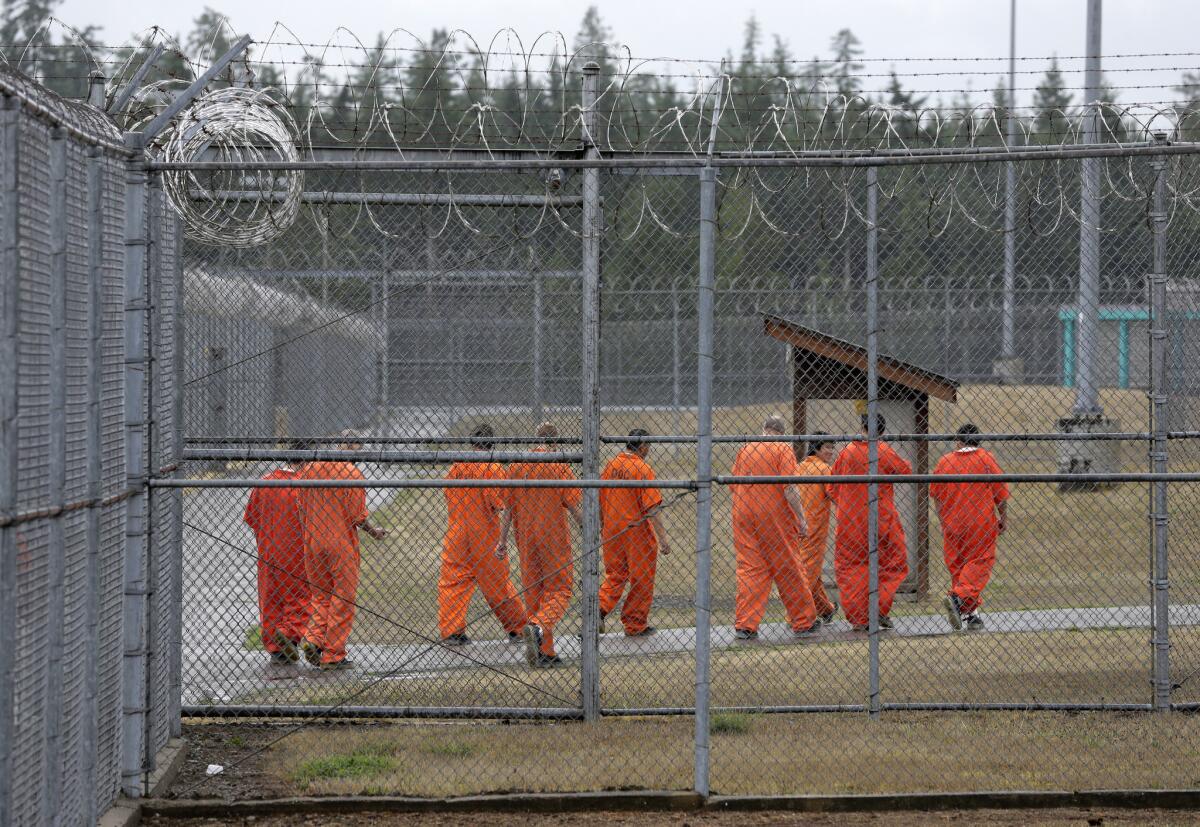U.S. to release 6,000 prisoners as part of sentencing-reform campaign

Prisoners walk toward an exercise yard at the Washington Corrections Center, in Shelton, Wash.
- Share via
Reporting from Washington — The federal Bureau of Prisons plans to release 6,000 prisoners at the end of October, implementing a decision last year to slash the number of incarcerated drug offenders by nearly half.
Officials said the nationwide releases over four days starting Oct. 30 will be the largest in U.S. history.
Last year, in line with a concerted effort by the Obama administration to reduce the number of drug offenders in U.S. prisons, the U.S. Sentencing Commission voted to cut drug sentences by an average of two years, potentially affecting as many as 46,000 of 100,000 cases.
NEWSLETTER: Get the day’s top headlines from Times Editor Davan Maharaj >>
In the coming year, an additional 8,550 prisoners will be eligible for release, according to Sentencing Commission spokesman Matt Osterrieder, though he said that not all of them will be approved.
When the mass release was first proposed, some federal prosecutors and even then-Atty. Gen. Eric H. Holder Jr. preferred a much narrower approach.
Under a compromise, the sentencing commission agreed to delay the releases until late this year, permitting a more thorough vetting of each case. Congress, where sentencing reform has had bipartisan support, allowed the changes to go into effect.
On Tuesday, the Justice Department was solidly behind the releases.
“The Department of Justice strongly supports sentencing reform for low-level, nonviolent drug offenders,” said Deputy Atty. Gen. Sally Yates. “The Sentencing Commission’s actions — which create modest reductions for drug offenders — is a step toward these necessary reforms.”
But officials said the releases are not limited to non-violent offenders, though each release is individually approved by a federal judge, who must make a determination that the person is not a threat to public safety. So far, Osterrieder said, judges are approving about 75% of requests for release.
Studies of previous but smaller mass releases in 2007, when sentences were adjusted for crack cocaine, showed that the recidivism rate for those released early was about the same as those released at the completion of their sentences, about 40 percent, Osterrieder said.
Justice Department spokeswoman Emily Pierce said that about one-third of those released will be deported because they are not U.S. citizens. Most of the others will be sent to halfway houses or supervised home-release, officials said.
The Obama administration and a bipartisan coalition in Congress have also been working on reforms to lower the country’s incarceration rate, one of the highest in the world.
But Obama’s 89 clemencies to date constitute a small fraction of about 8,000 clemency petitions pending from prisoners. His efforts have so far fallen short of expectations set in April, when the Justice Department announced the most ambitious federal clemency program in 40 years and invited lawyers across the country to help tens of thousands of federal drug offenders apply.
A bipartisan group of senators recently announced agreement on a bill to reduce mandatory minimum prison sentences, and a hearing on the proposal is expected this month.
Twitter: @timphelpsLAT
ALSO:
In writings, Oregon gunman ranted about others being crazy
California voters overwhelmingly support end-of-life law, poll finds
Top U.S. commander in Afghanistan says attack on civilian hospital was a mistake
More to Read
Sign up for Essential California
The most important California stories and recommendations in your inbox every morning.
You may occasionally receive promotional content from the Los Angeles Times.











